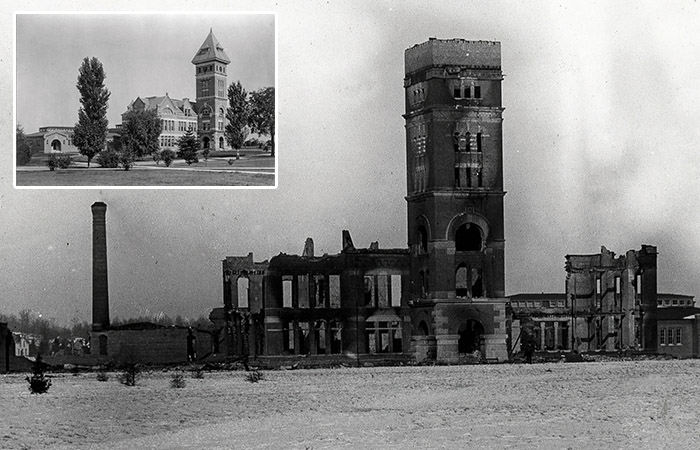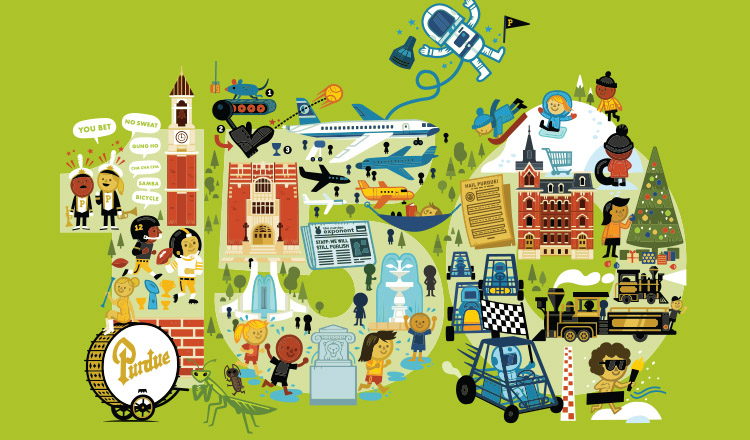Lasting legacies from university leadership
1. Campus Beautification under President Beering
In the postwar enrollment boom, Purdue’s rapid expansion didn’t permit much attention to aesthetics, as symbolized by the ubiquitous prefabricated Quonset huts and “black and whites” — manufactured houses for faculty. Because of this, Purdue’s campus got several less-than-flattering nicknames, such as “the brick factory” and “the prison.” In the 1980s, President Steven Beering (HDR S’00) made campus beautification a priority and commissioned a campus master plan. The plan replaced pavement and parking with parks, malls, and trees. Maybe you need to walk a little further from your car these days, but the walk is a lot more pleasant.
2. Windbreak
If you’re new to central Indiana, the landscape might seem somewhat barren. But it’s nothing compared to the early days. According to an account in A University of Tradition, Purdue was a handful of buildings in a “treeless expanse of farmland.” Trustee Martin L. Peirce wanted to change that, at least in part, and donated his salary from his treasurer responsibilities to beautifying campus. Dating back to the 1870s, some of the evergreens Peirce helped plant can be seen to this day between Elliott Hall of Music and the Psychological Sciences Building.
3. Land-Grant University
Signed into law by President Abraham Lincoln, the Land-Grant College Act of 1862, also known as the Morrill Act, provided states with parcels of federal land that could be sold to help finance the establishment of colleges of agricultural and mechanic arts. Indiana elected to participate in the program in 1865, but it would take four years for the state’s legislature to identify a location for the land-grant university. Bidding was fierce between existing colleges — such as Indiana University in Bloomington, Northwestern Christian in Indianapolis, and the Stockwell and Battle Ground Collegiate Institutes — who were eager to add agricultural and mechanical courses to their curricula. Tippecanoe and Marion Counties submitted proposals as well, but IU’s offer appeared to be the most favorable to the state. In order to make Tippecanoe County stand out, local commissioners sought monetary support from the area’s residents. John Purdue agreed to contribute $100,000 in cash for the new school, provided it was located in Battle Ground and named for him. Over time, he changed his views on the location; increased his donation to $150,000; and promised to procure 100 acres of land. On May 6, 1969, Purdue’s proposition was approved by the Indiana General Assembly, and Purdue University was founded.

4. One Brick Higher
In October 1892, President James H. Smart announced a significant gift to the University: Amos Heavilon, a farmer and businessman from Frankfort, gave property, notes, and cash worth $35,000 to Purdue. With additional state funding, Purdue constructed Heavilon Hall, dedicated on January 19, 1894. Just four days later, a boiler inside the building exploded. Fire ripped through Heavilon Hall, destroying it and most of its contents, including the groundbreaking Locomotive Testing Plant. Only the charred remnants of the building’s tower remained standing, and it had to be demolished just a short time later. The Purdue community was devastated. The day after the fire, however, Smart stood before Purdue’s faculty and students and proclaimed, “We are looking this morning to the future, not the past. … I tell you, young men, that tower shall go up one brick higher.” The rebuilt Heavilon Hall was completed in December 1895, and the first classes in it were held shortly after. Thanks to the generosity of Purdue’s partner manufacturers, most of the engines and laboratory materials that were destroyed in the fire were replaced free of charge. True to Smart’s vow, the building’s tower had been rebuilt higher than the original — nine bricks higher, to be exact. The 140-foot-tall tower differed from its predecessor with the addition of a clock and four bells that chimed on the quarter-hour. The phrase “one brick higher” embodies Boilermakers’ characteristic determination and dedication and is another reminder of the determination of a campus that met devastating adversity with a resilience that lives on to this day.

